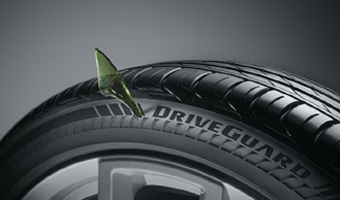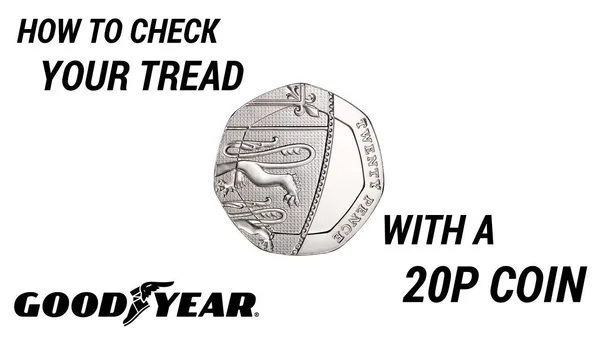How to check your tyre treads
- Share via X
- Share via Facebook
- Share via Pinterest
- Share via LinkedIn
-
Copy to your clipboard
Checking your tyre treads is quite easy, and there’s three specific ways you can do it.

Checking your tyre treads is quite easy, and there’s three specific ways you can do it:
- Tread Wear Indicators – your car tyres should have tread wear indicators. Look for the TWI symbol on the sidewall. You should be able to see tread wear indicator bars in the grooves of your tyre’s tread aligned with the TWI symbol. If the bars are smooth with your tyre tread, it’s time to invest in new tyres.
- 20p Test – it’s a simple test, but well worth doing. Take a 20p coin and insert it into the grooves on your tyre. If you can see the outer band of the coin, your tyres will need to be replaced.
- Tread Depth Gauge – if the 20p test isn’t for you, you can purchase a tread depth gauge instead. They’re also small enough to fit in your glove compartment, and are easy to use to measure your tread depth.
Did you know that 28% of vehicles fail their first MOT test due to tyre issues? Don't be one of them. Learn how to check your tyre treads easily with Goodyear's new animation.
What is the Minimum Legal Tread Depth?
By law your tread depth needs to be a minimum of 1.6mm. Once you have a tread depth below 1.6mm, you need to replace your tyres. However, you should consider replacing your tyres once they get below 3mm. At a tread depth of 3mm, your tyres grip is already compromised, which is especially important when braking in wet conditions. For winter tyres, they should have a minimum of 4mm tread depth.
What is the Tread Depth of a New Tyre?
If you need to replace your tyres at a tread depth of 1.6mm, what’s the tread depth of new tyres? Typically, a new tyre will have at least 8mm of tread. So when you have a brand new set of tyres on your car, they are almost 8 times the legal limit.
1.6mm vs 8mm is a huge difference and has a big impact on braking distances whether you’re driving on a dry road at 30mph or a wet motorway at 70mph. A car with a new set of tyres will come to a stop a lot sooner than a car with the minimum legal tread depth. And that could be the difference between a costly collision and safely avoiding an accident.
What Causes Tyre Wear?
You need to look after your tyres well in order to ensure they stand the test of time. There are several factors which can cause your tyres to wear faster:
- Driving style and driving habits – if you find yourself accelerating heavily and braking suddenly, this will impact on the tyres quite extensively and mean your tread will wear quicker
- Overloading – your car has a load index that corresponds with the maximum weight you should have in your car at any one time. If you overload your car, this will impact on the tyres and cause the tread to wear down quicker
- Incorrect Tyre Pressure – underinflation and overinflation can both have detrimental effects on your tread wear. Overinflation will impact the centre of the tyre and causes it to bulge. Underinflation causes wear on the outer edge of the tyre. To prevent this, you will need to inflate your tyres to the required pressure for your vehicle. Check your recommended tyre pressure here.
- Misalignment – if your tyres are not properly aligned, they will wear faster on one side of the tyre.
You can see the dramatic impacts this can have on your tyres in our chamber of horrors, which provides examples of illegal tyres.
Tread Wear Damage to Look Out For
There are several effects of tread wear that you need to look out for in order to maintain your tyres well:
- Foreign object lodged in tread – small stones or grit are usually relatively harmless and can be removed easily. However, occasionally you may find something a bit more worrying such as a nail or a screw. In this case, take your car to your nearest HiQ Centre to get your tyre repaired by an expert technician.
- Tyre wear in the centre of the tyre – this is a sign of over-inflation. Check your recommended tyre pressure and deflate your tyres.
- Tyre wear on the outside - tyre wear on the outside edges of your tyre is a sign that your tyres are underinflated. Check your recommended tyre pressure and inflate your tyres.
- Uneven wear - uneven wear or bald spots on one of your tyres, is a sign of tyre or wheel imbalance, which means you’ll need to get them realigned.
How often do I need to check my tyre tread?
You should ideally check your tyres every time you’re about to go on a journey in your car. If you notice any significant damage, you can take the necessary steps to ensure your safety. Your vehicle handbook may also provide guidance on how regularly to check your tyre tread depth.
Tyre Maintenance
Tyres will provide greater life if they are properly maintained. It is an inexpensive task and the following checklist will be helpful:
- Check the correct pressures against the manufacturer's recommendations as given in the vehicle Handbook. Adjust pressures as necessary
- Clean dirt from valves and fit valve caps all round
- Remove stones and other foreign objects from treads
- Have the steering alignment checked if front tyres show signs of excessive or uneven wear
- Examine brakes if tyres show signs of wear through wheel locking
- Have front wheels and tyres balanced if there are signs of vibration, wheel wobble or patchy tyre wear
